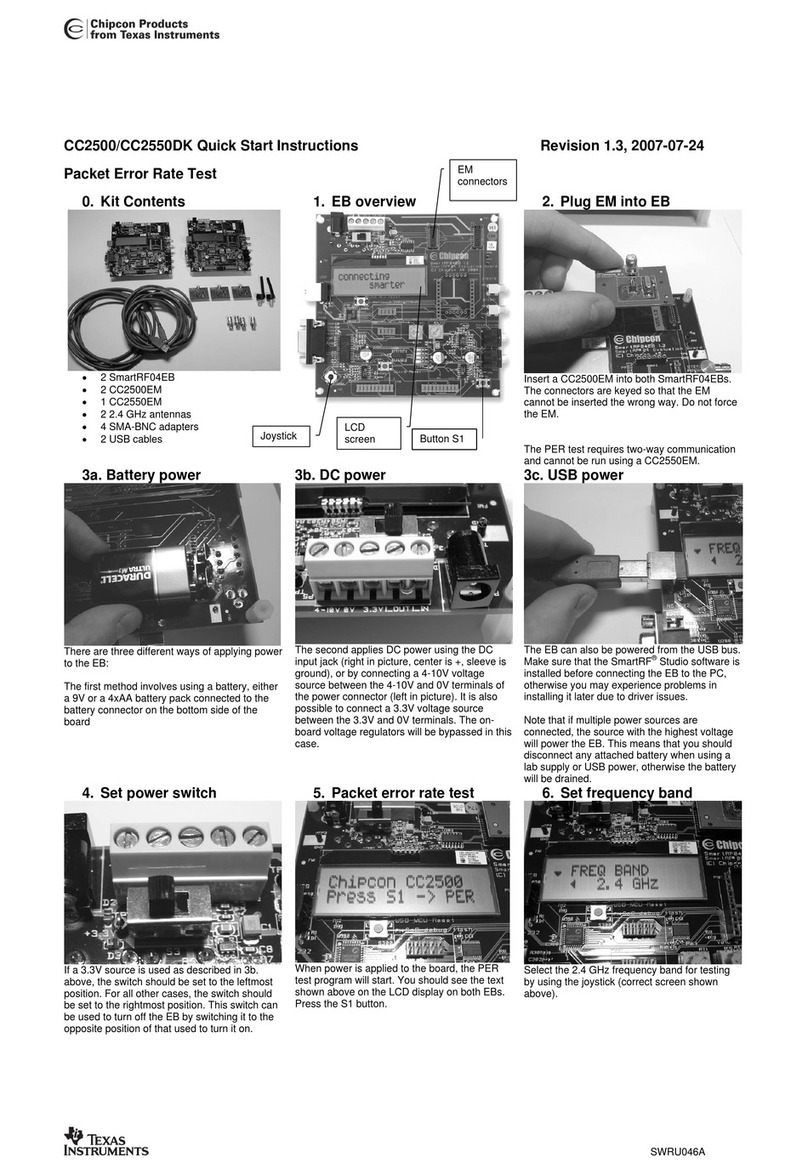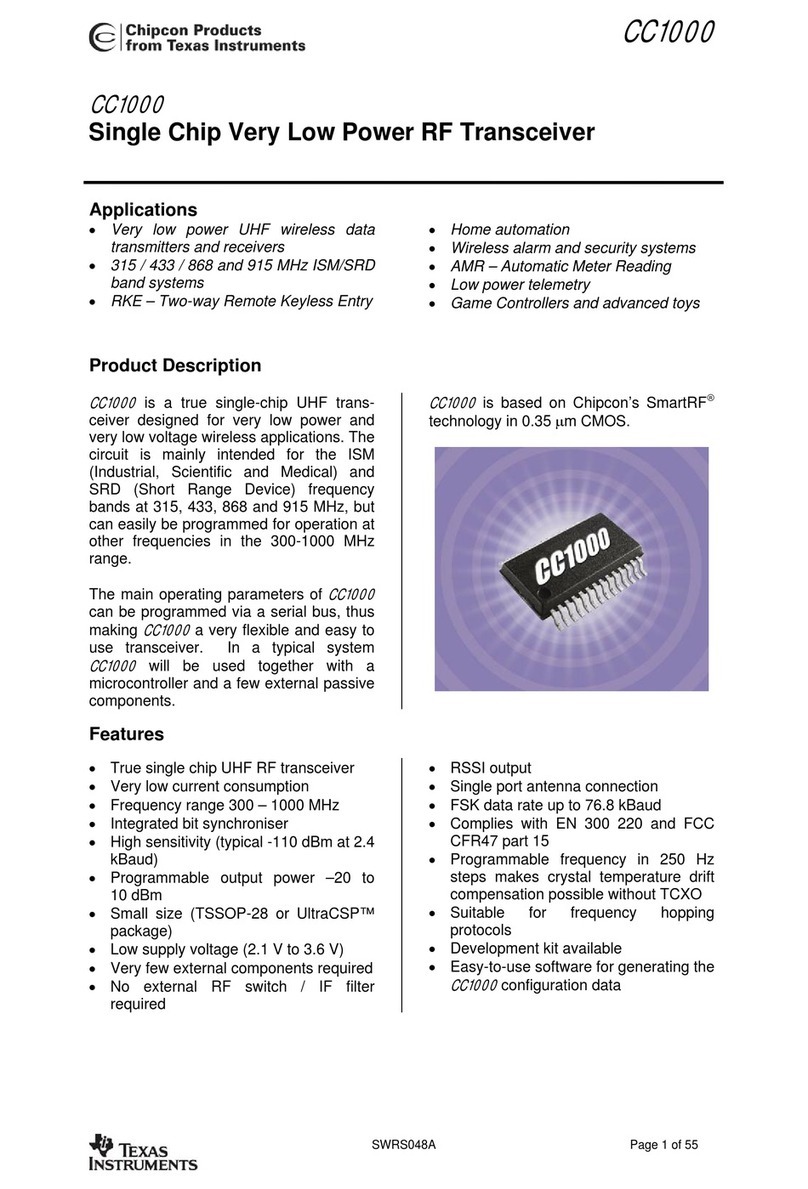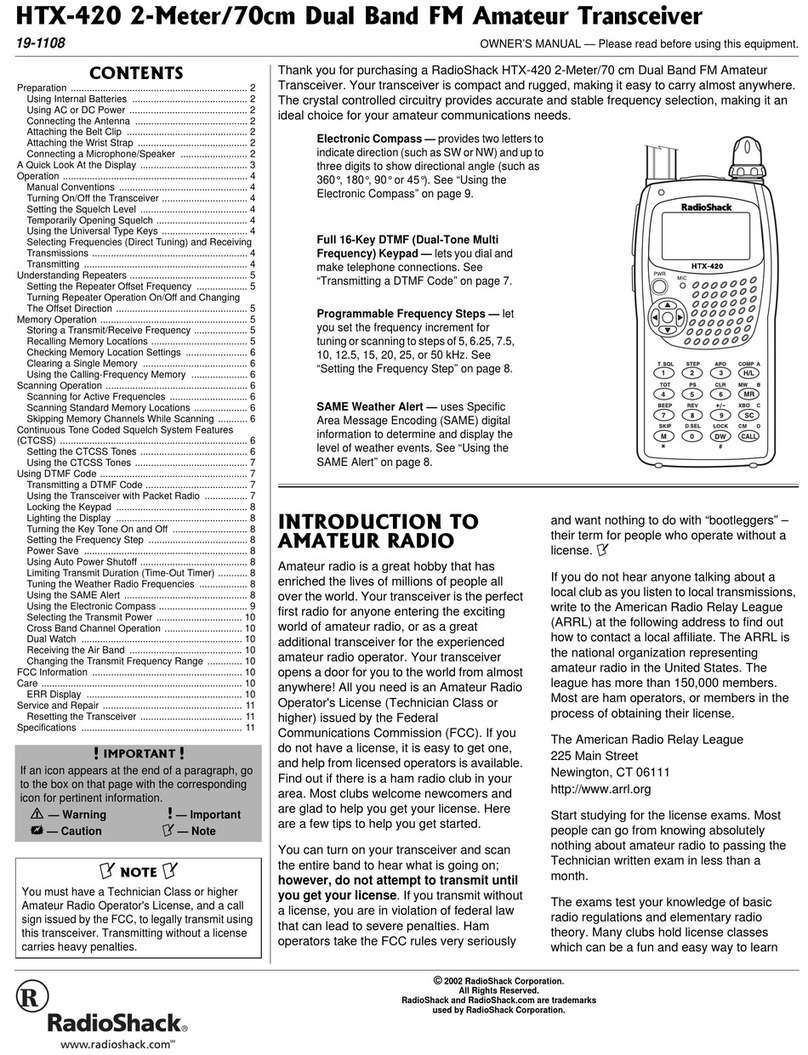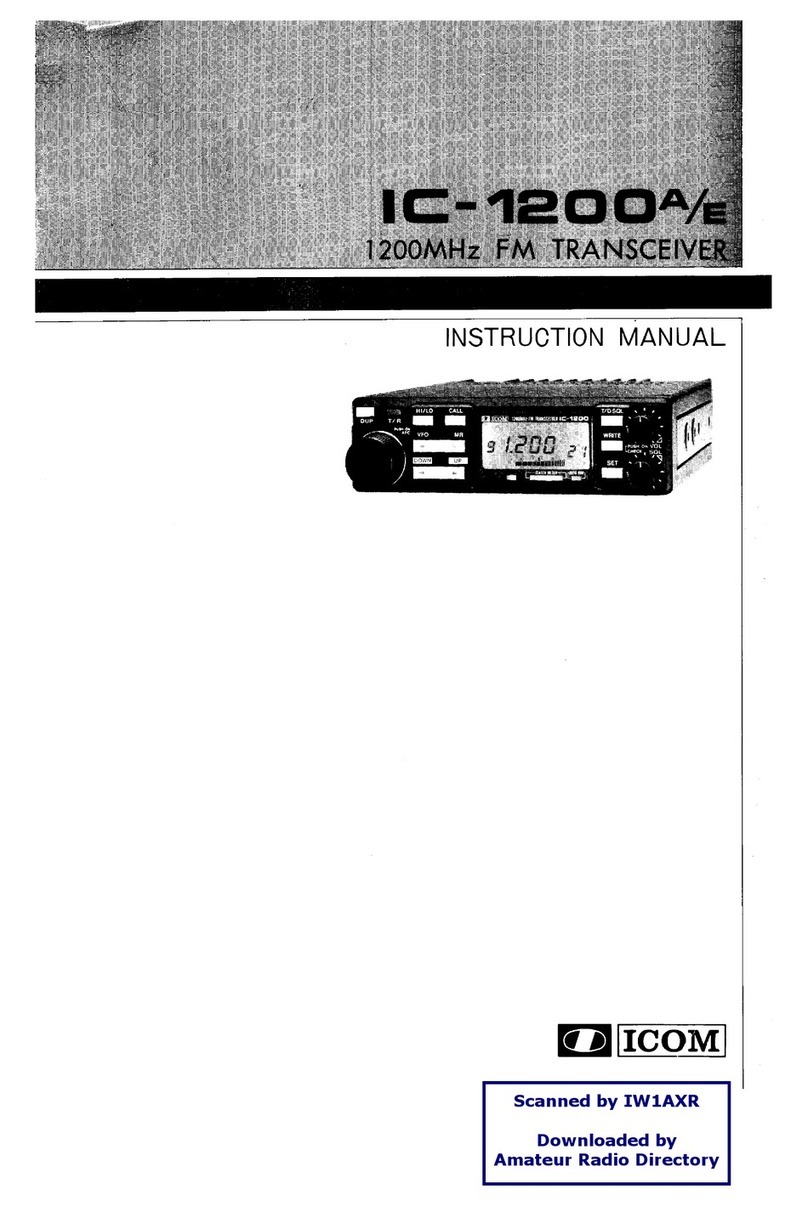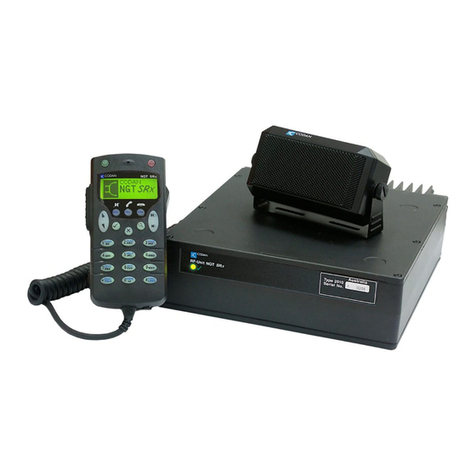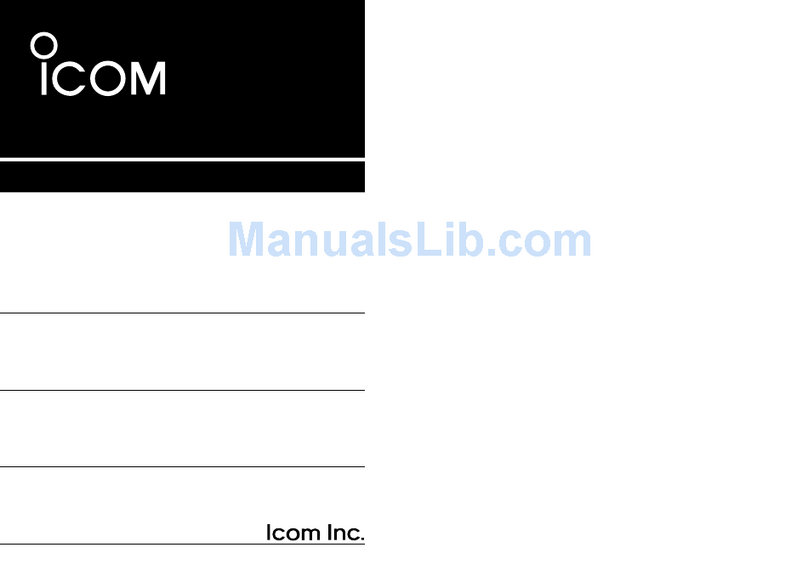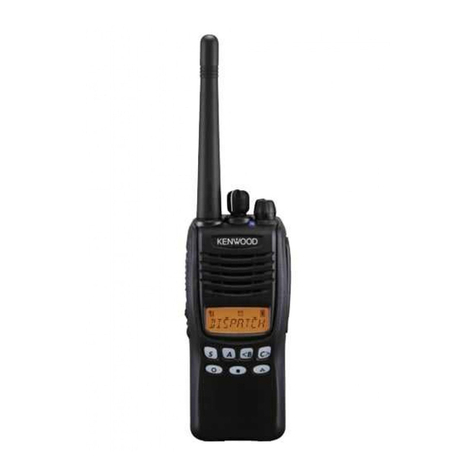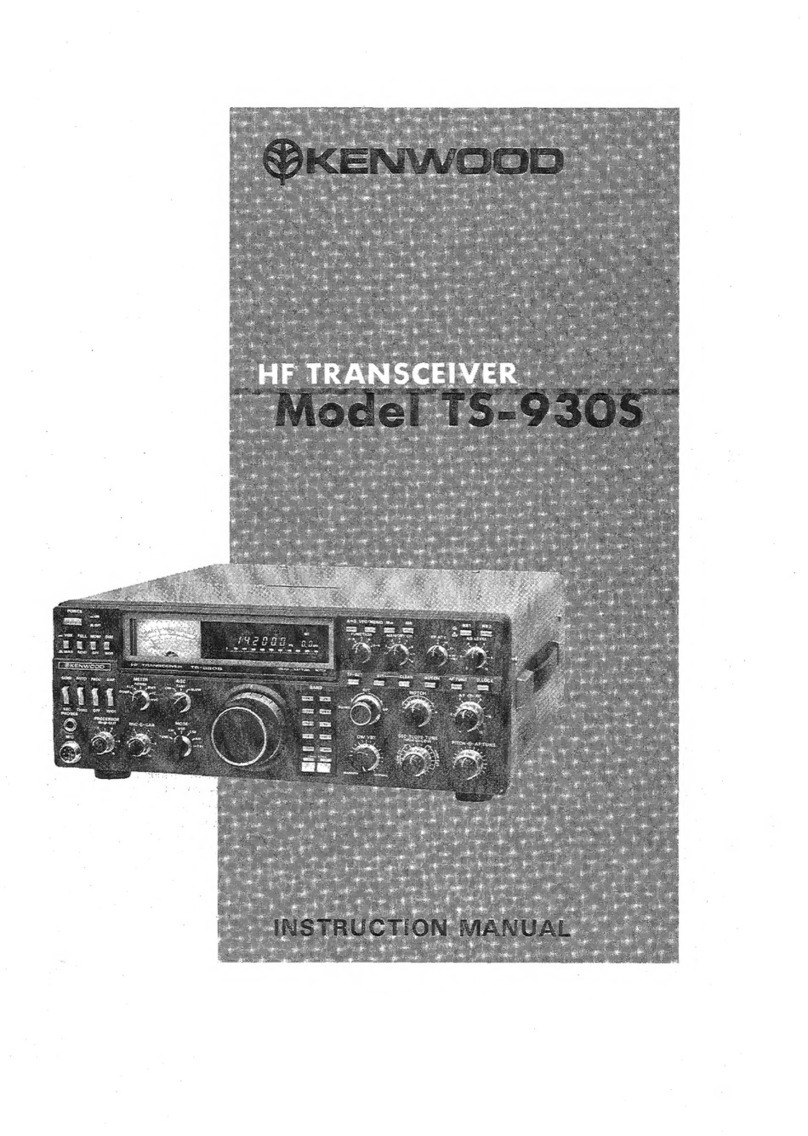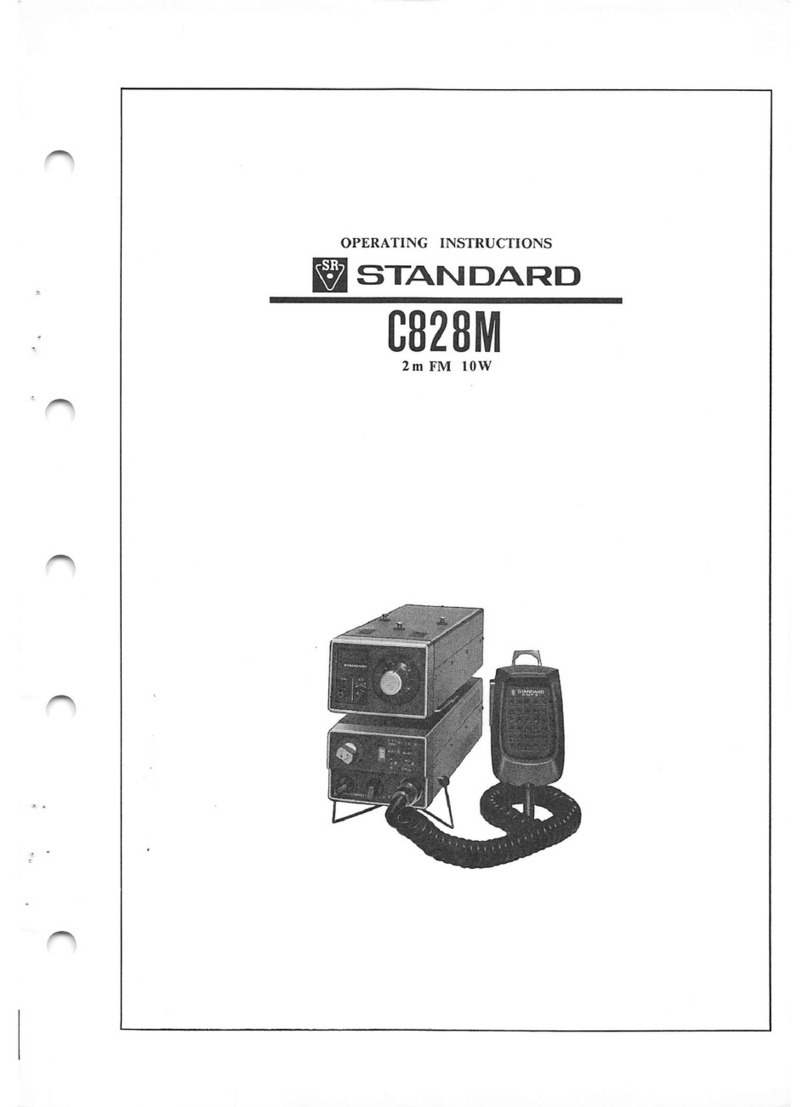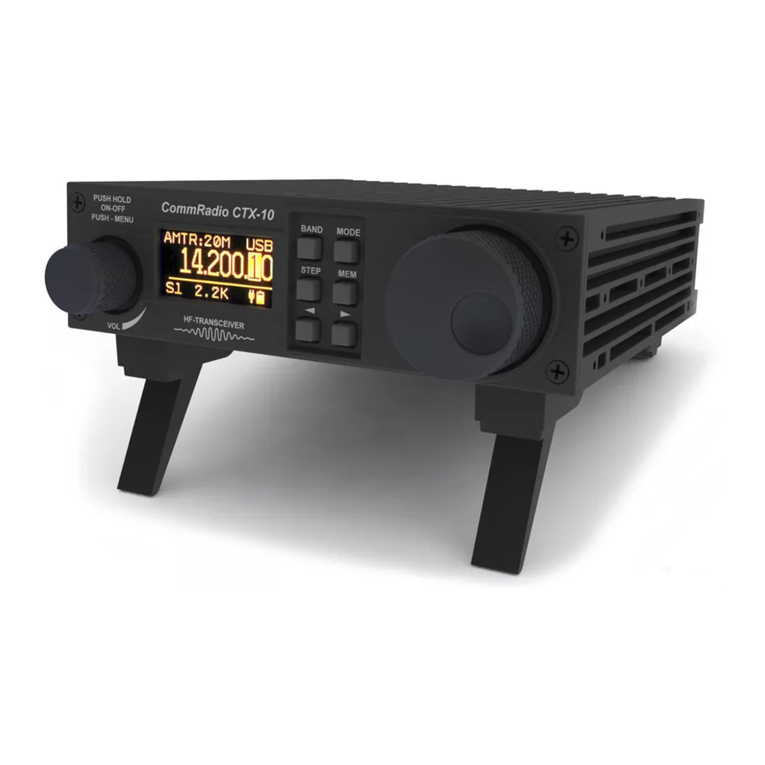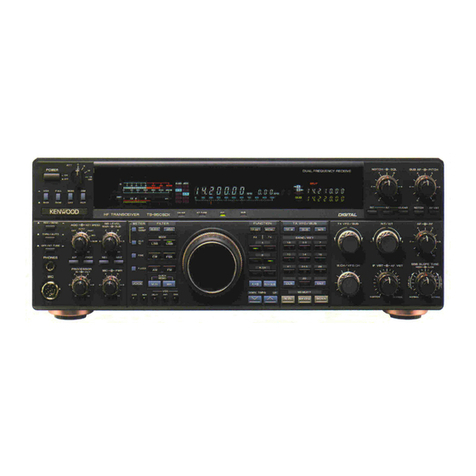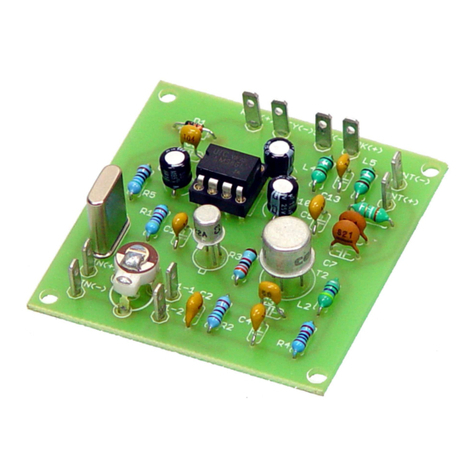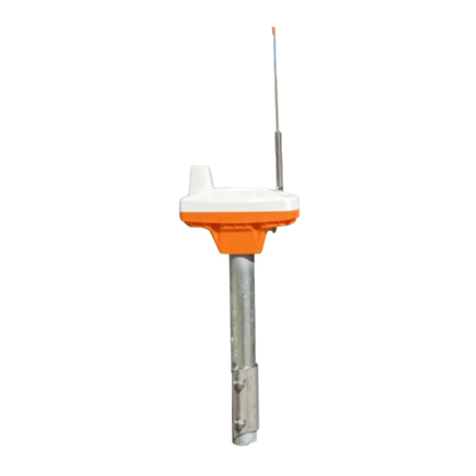Chipcon CC2500 User manual

CC2500
SWRS040B Page 1 of 92
CC2500
Low-Cost Low-Power 2.4 GHz RF Transceiver
Applications
•2400-2483.5 MHz ISM/SRD band systems
•Consumer electronics
•Wireless game controllers
•Wireless audio
•Wireless keyboard and mouse
•RF enabled remote controls
Product Description
The
CC2500
is a low-cost 2.4 GHz transceiver
designed for very low-power wireless appli-
cations. The circuit is intended for the 2400-
2483.5 MHz ISM (Industrial, Scientific and
Medical) and SRD (Short Range Device)
frequency band.
The RF transceiver is integrated with a highly
configurable baseband modem. The modem
supports various modulation formats and has
a configurable data rate up to 500 kBaud.
CC2500
provides extensive hardware support
for packet handling, data buffering, burst
transmissions, clear channel assessment, link
quality indication, and wake-on-radio.
The main operating parameters and the 64-
byte transmit/receive FIFOs of
CC2500
can be
controlled via an SPI interface. In a typical
system, the
CC2500
will be used together with
a microcontroller and a few additional passive
components.
6
7
8
9
10
20
19
18
17
16
Key Features
RF Performance
•High sensitivity (–104 dBm at 2.4 kBaud,
1% packet error rate)
•Low current consumption (13.3 mA in RX,
250 kBaud, input well above sensitivity
limit)
•Programmable output power up to +1 dBm
•Excellent receiver selectivity and blocking
performance
•Programmable data rate from 1.2 to 500
kBaud
•Frequency range: 2400 – 2483.5 MHz
Analog Features
•OOK, 2-FSK, GFSK, and MSK supported
•Suitable for frequency hopping and multi-
channel systems due to a fast settling
frequency synthesizer with 90 us settling
time
•Automatic Frequency Compensation
(AFC) can be used to align the frequency
synthesizer to the received centre
frequency
•Integrated analog temperature sensor
Digital Features
•Flexible support for packet oriented
systems: On-chip support for sync word
detection, address check, flexible packet
length, and automatic CRC handling
•Efficient SPI interface: All registers can be
programmed with one “burst” transfer
•Digital RSSI output
•Programmable channel filter bandwidth
•Programmable Carrier Sense (CS)
indicator

CC2500
SWRS040B Page 2 of 92
•Programmable Preamble Quality Indicator
(PQI) for improved protection against false
sync word detection in random noise
•Support for automatic Clear Channel
Assessment (CCA) before transmitting (for
listen-before-talk systems)
•Support for per-package Link Quality
Indication (LQI)
•Optional automatic whitening and de-
whitening of data
Low-Power Features
•400 nA SLEEP mode current consumption
•Fast startup time: 240 us from SLEEP to
RX or TX mode (measured on EM design)
•Wake-on-radio functionality for automatic
low-power RX polling
•Separate 64-byte RX and TX data FIFOs
(enables burst mode data transmission)
General
•Few external components: Complete on-
chip frequency synthesizer, no external
filters or RF switch needed
•Green package: RoHS compliant and no
antimony or bromine
•Small size (QLP 4x4 mm package, 20
pins)
•Suited for systems compliant with EN 300
328 and EN 300 440 class 2 (Europe),
FCC CFR47 Part 15 (US), and ARIB STD-
T66 (Japan)
•Support for asynchronous and
synchronous serial receive/transmit mode
for backwards compatibility with existing
radio communication protocols

CC2500
SWRS040B Page 3 of 92
Abbreviations
Abbreviations used in this data sheet are described below.
ACP Adjacent Channel Power MSB Most Significant Bit
ADC Analog to Digital Converter MSK Minimum Shift Keying
AFC Automatic Frequency Offset Compensation NA Not Applicable
AGC Automatic Gain Control NRZ Non Return to Zero (Coding)
AMR Automatic Meter Reading OOK On Off Keying
ARIB Association of Radio Industries and Businesses PA Power Amplifier
BER Bit Error Rate PCB Printed Circuit Board
BT Bandwidth-Time product PD Power Down
CCA Clear Channel Assessment PER Packet Error Rate
CFR Code of Federal Regulations PLL Phase Locked Loop
CRC Cyclic Redundancy Check POR Power-on Reset
CS Carrier Sense PQI Preamble Quality Indicator
CW Continuous Wave (Unmodulated Carrier) PQT Preamble Quality Threshold
DC Direct Current RCOSC RC Oscillator
DVGA Digital Variable Gain Amplifier QPSK Quadrature Phase Shift Keying
ESR Equivalent Series Resistance QLP Quad Leadless Package
FCC Federal Communications Commission RC Resistor-Capacitor
FEC Forward Error Correction RF Radio Frequency
FIFO First-In-First-Out RSSI Received Signal Strength Indicator
FHSS Frequency Hopping Spread Spectrum RX Receive, Receive Mode
2-FSK Frequency Shift Keying SMD Surface Mount Device
GFSK Gaussian shaped Frequency Shift Keying SNR Signal to Noise Ratio
IF Intermediate Frequency SPI Serial Peripheral Interface
I/Q In-Phase/Quadrature SRD Short Range Device
ISM Industrial, Scientific and Medical T/R Transmit/Receive
LBT Listen Before Transmit TX Transmit, Transmit Mode
LC Inductor-Capacitor VCO Voltage Controlled Oscillator
LNA Low Noise Amplifier WLAN Wireless Local Area Networks
LO Local Oscillator WOR Wake on Radio, Low power polling
LQI Link Quality Indicator XOSC Crystal Oscillator
LSB Least Significant Bit XTAL Crystal
MCU Microcontroller Unit

CC2500
SWRS040B Page 4 of 92
Table of Contents
APPLICATIONS...........................................................................................................................................1
PRODUCT DESCRIPTION.........................................................................................................................1
KEY FEATURES..........................................................................................................................................1
RF PERFORMANCE ...........................................................................................................................................1
ANALOG FEATURES..........................................................................................................................................1
DIGITAL FEATURES ..........................................................................................................................................1
LOW-POWER FEATURES ...................................................................................................................................2
GENERAL..........................................................................................................................................................2
ABBREVIATIONS........................................................................................................................................3
TABLE OF CONTENTS..............................................................................................................................4
1ABSOLUTE MAXIMUM RATINGS...........................................................................................................7
2OPERATING CONDITIONS......................................................................................................................7
3GENERAL CHARACTERISTICS ...............................................................................................................7
4ELECTRICAL SPECIFICATIONS...............................................................................................................8
4.1 CURRENT CONSUMPTION .....................................................................................................................8
4.2 RF RECEIVE SECTION.........................................................................................................................10
4.3 RF TRANSMIT SECTION......................................................................................................................12
4.4 CRYSTAL OSCILLATOR.......................................................................................................................13
4.5 LOW POWER RC OSCILLATOR............................................................................................................13
4.6 FREQUENCY SYNTHESIZER CHARACTERISTICS...................................................................................14
4.7 ANALOG TEMPERATURE SENSOR .......................................................................................................15
4.8 DC CHARACTERISTICS .......................................................................................................................15
4.9 POWER-ON RESET..............................................................................................................................15
5PIN CONFIGURATION..........................................................................................................................16
6CIRCUIT DESCRIPTION........................................................................................................................18
7APPLICATION CIRCUIT........................................................................................................................18
8CONFIGURATION OVERVIEW ..............................................................................................................20
9CONFIGURATION SOFTWARE ..............................................................................................................21
10 4-WIRE SERIAL CONFIGURATION AND DATA INTERFACE ...................................................................22
10.1 CHIP STATUS BYTE ............................................................................................................................23
10.2 REGISTER ACCESS..............................................................................................................................24
10.3 SPI READ ...........................................................................................................................................24
10.4 COMMAND STROBES ..........................................................................................................................25
10.5 FIFO ACCESS.....................................................................................................................................25
10.6 PATABLE ACCESS.............................................................................................................................25
11 MICROCONTROLLER INTERFACE AND PIN CONFIGURATION...............................................................26
11.1 CONFIGURATION INTERFACE..............................................................................................................26
11.2 GENERAL CONTROL AND STATUS PINS ..............................................................................................26
11.3 OPTIONAL RADIO CONTROL FEATURE ...............................................................................................27
12 DATA RATE PROGRAMMING...............................................................................................................27
13 RECEIVER CHANNEL FILTER BANDWIDTH..........................................................................................28
14 DEMODULATOR,SYMBOL SYNCHRONIZER AND DATA DECISION.......................................................28
14.1 FREQUENCY OFFSET COMPENSATION.................................................................................................28
14.2 BIT SYNCHRONIZATION......................................................................................................................28
14.3 BYTE SYNCHRONIZATION...................................................................................................................29
15 PACKET HANDLING HARDWARE SUPPORT .........................................................................................29
15.1 DATA WHITENING..............................................................................................................................30
15.2 PACKET FORMAT................................................................................................................................30
15.3 PACKET FILTERING IN RECEIVE MODE...............................................................................................32
15.4 CRC CHECK.......................................................................................................................................32
15.5 PACKET HANDLING IN TRANSMIT MODE............................................................................................33
15.6 PACKET HANDLING IN RECEIVE MODE ..............................................................................................33
15.7 PACKET HANDLING IN FIRMWARE......................................................................................................34
16 MODULATION FORMATS.....................................................................................................................34
16.1 FREQUENCY SHIFT KEYING................................................................................................................34
16.2 MINIMUM SHIFT KEYING....................................................................................................................34

CC2500
SWRS040B Page 5 of 92
16.3 AMPLITUDE MODULATION .................................................................................................................35
17 RECEIVED SIGNAL QUALIFIERS AND LINK QUALITY INFORMATION...................................................35
17.1 SYNC WORD QUALIFIER.....................................................................................................................35
17.2 PREAMBLE QUALITY THRESHOLD (PQT)...........................................................................................35
17.3 RSSI...................................................................................................................................................35
17.4 CARRIER SENSE (CS)..........................................................................................................................36
17.5 CLEAR CHANNEL ASSESSMENT (CCA) ..............................................................................................38
17.6 LINK QUALITY INDICATOR (LQI).......................................................................................................38
18 FORWARD ERROR CORRECTION WITH INTERLEAVING........................................................................38
18.1 FORWARD ERROR CORRECTION (FEC)...............................................................................................38
18.2 INTERLEAVING ...................................................................................................................................39
19 RADIO CONTROL ................................................................................................................................40
19.1 POWER-ON START-UP SEQUENCE......................................................................................................40
19.2 CRYSTAL CONTROL............................................................................................................................41
19.3 VOLTAGE REGULATOR CONTROL.......................................................................................................41
19.4 ACTIVE MODES ..................................................................................................................................42
19.5 WAKE ON RADIO (WOR)...................................................................................................................42
19.6 TIMING ...............................................................................................................................................43
19.7 RX TERMINATION TIMER...................................................................................................................44
20 DATA FIFO........................................................................................................................................44
21 FREQUENCY PROGRAMMING ..............................................................................................................45
22 VCO...................................................................................................................................................46
22.1 VCO AND PLL SELF-CALIBRATION ...................................................................................................46
23 VOLTAGE REGULATORS .....................................................................................................................47
24 OUTPUT POWER PROGRAMMING ........................................................................................................47
25 SELECTIVITY ......................................................................................................................................49
26 CRYSTAL OSCILLATOR.......................................................................................................................51
26.1 REFERENCE SIGNAL ...........................................................................................................................51
27 EXTERNAL RF MATCH .......................................................................................................................51
28 PCB LAYOUT RECOMMENDATIONS....................................................................................................52
29 GENERAL PURPOSE /TEST OUTPUT CONTROL PINS ...........................................................................53
30 ASYNCHRONOUS AND SYNCHRONOUS SERIAL OPERATION................................................................55
30.1 ASYNCHRONOUS OPERATION.............................................................................................................55
30.2 SYNCHRONOUS SERIAL OPERATION ...................................................................................................55
31 SYSTEM CONSIDERATIONS AND GUIDELINES .....................................................................................55
31.1 SRD REGULATIONS............................................................................................................................55
31.2 FREQUENCY HOPPING AND MULTI-CHANNEL SYSTEMS.....................................................................56
31.3 WIDEBAND MODULATION NOT USING SPREAD SPECTRUM ................................................................56
31.4 DATA BURST TRANSMISSIONS............................................................................................................56
31.5 CONTINUOUS TRANSMISSIONS ...........................................................................................................56
31.6 CRYSTAL DRIFT COMPENSATION .......................................................................................................57
31.7 SPECTRUM EFFICIENT MODULATION..................................................................................................57
31.8 LOW COST SYSTEMS ..........................................................................................................................57
31.9 BATTERY OPERATED SYSTEMS ..........................................................................................................57
31.10 INCREASING OUTPUT POWER .........................................................................................................57
32 CONFIGURATION REGISTERS ..............................................................................................................58
32.1 CONFIGURATION REGISTER DETAILS –REGISTERS WITH PRESERVED VALUES IN SLEEP STATE ......62
32.2 CONFIGURATION REGISTER DETAILS –REGISTERS THAT LOSE PROGRAMMING IN SLEEP STATE.....81
32.3 STATUS REGISTER DETAILS................................................................................................................82
33 PACKAGE DESCRIPTION (QLP 20)......................................................................................................86
33.1 RECOMMENDED PCB LAYOUT FOR PACKAGE (QLP 20)....................................................................87
33.2 SOLDERING INFORMATION .................................................................................................................87
33.3 TRAY SPECIFICATION .........................................................................................................................87
33.4 CARRIER TAPE AND REEL SPECIFICATION..........................................................................................88
34 ORDERING INFORMATION...................................................................................................................88
35 REFERENCES.......................................................................................................................................88
36 GENERAL INFORMATION ....................................................................................................................89
36.1 DOCUMENT HISTORY .........................................................................................................................89
36.2 PRODUCT STATUS DEFINITIONS .........................................................................................................90

CC2500
SWRS040B Page 6 of 92
37 ADDRESS INFORMATION.....................................................................................................................91
38 TI WORLDWIDE TECHNICAL SUPPORT ...............................................................................................91

CC2500
SWRS040B Page 7 of 92
1 Absolute Maximum Ratings
Under no circumstances must the absolute maximum ratings given in Table 1 be violated. Stress
exceeding one or more of the limiting values may cause permanent damage to the device.
Caution! ESD sensitive device.
Precaution should be used when handling
the device in order to prevent permanent
damage.
Parameter Min Max Unit Condition
Supply voltage –0.3 3.9 V All supply pins must have the same voltage
Voltage on any digital pin –0.3 VDD+0.3,
max 3.9
V
Voltage on the pins RF_P, RF_N
and DCOUPL
–0.3 2.0 V
Voltage ramp-up rate 120 kV/µs
Input RF level +10 dBm
Storage temperature range –50 150 °C
Solder reflow temperature 260 °C According to IPC/JEDEC J-STD-020D
ESD <500 V According to JEDEC STD 22, method A114,
Human Body Model
Table 1: Absolute Maximum Ratings
2 Operating Conditions
The
CC2500
operating conditions are listed in Table 2 below.
Parameter Min Max Unit Condition
Operating temperature –40 85 °C
Operating supply voltage 1.8 3.6 V All supply pins must have the same voltage
Table 2: Operating Conditions
3 General Characteristics
Parameter Min Typ Max Unit Condition/Note
Frequency range 2400 2483.5 MHz There will be spurious signals at n/2·crystal oscillator
frequency (n is an integer number). RF frequencies at
n/2·crystal oscillator frequency should therefore be
avoided (e.g. 2405, 2418, 2431, 2444, 2457, 2470 and
2483 MHz when using a 26 MHz crystal).
Data rate 1.2
1.2
26
500
250
500
kBaud
kBaud
kBaud
2-FSK
GFSK and OOK
(Shaped) MSK (also known as differential offset
QPSK)
Optional Manchester encoding (the data rate in kbps
will be half the baud rate).
Table 3: General Characteristics

CC2500
SWRS040B Page 8 of 92
4 Electrical Specifications
4.1 Current Consumption
Tc = 25°C, VDD = 3.0 V if nothing else stated. All measurement results obtained using the CC2500EM reference design
([4]).
Parameter Min Typ Max Unit Condition
400 nA Voltage regulator to digital part off, register values retained
(SLEEP state). All GDO pins programmed to 0x2F (HW to 0)
900 nA Voltage regulator to digital part off, register values retained, low-
power RC oscillator running (SLEEP state with WOR enabled)
92 µA Voltage regulator to digital part off, register values retained,
XOSC running (SLEEP state with MCSM0.OSC_FORCE_ON set)
Current consumption in
power down modes
160 µA Voltage regulator to digital part on, all other modules in power
down (XOFF state)
8.1 µA Automatic RX polling once each second, using low-power RC
oscillator, with 460 kHz filter bandwidth and 250 kBaud data rate,
PLL calibration every 4th wakeup. Average current with signal in
channel below carrier sense level (MCSM2.RX_TIME_RSSI=1).
35 µA Same as above, but with signal in channel above carrier sense
level, 1.95 ms RX timeout, and no preamble/sync word found.
1.4 µA Automatic RX polling every 15th second, using low-power RC
oscillator, with 460 kHz filter bandwidth and 250 kBaud data rate,
PLL calibration every 4th wakeup. Average current with signal in
channel below carrier sense level (MCSM2.RX_TIME_RSSI=1).
34 µA Same as above, but with signal in channel above carrier sense
level, 29.3 ms RX timeout, and no preamble/sync word found.
1.5 mA Only voltage regulator to digital part and crystal oscillator running
(IDLE state)
Current consumption
7.4 mA Only the frequency synthesizer is running (FSTXON state). This
currents consumption is also representative for the other
intermediate states when going from IDLE to RX or TX, including
the calibration state.
17.0 mA Receive mode, 2.4 kBaud, input at sensitivity limit,
MDMCFG2.DEM_DCFILT_OFF=0
14.5 mA Receive mode, 2.4 kBaud, input well above sensitivity limit,
MDMCFG2.DEM_DCFILT_OFF=0
17.3 mA Receive mode, 10 kBaud, input at sensitivity limit,
MDMCFG2.DEM_DCFILT_OFF=0
14.9 mA Receive mode, 10 kBaud, input well above sensitivity limit,
MDMCFG2.DEM_DCFILT_OFF=0
18.8 mA Receive mode, 250 kBaud, input at sensitivity limit,
MDMCFG2.DEM_DCFILT_OFF=0
15.7 mA Receive mode, 250 kBaud, input well above sensitivity limit,
MDMCFG2.DEM_DCFILT_OFF=0
16.6 mA Receive mode, 250 kBaud current optimized, input at sensitivity
limit, MDMCFG2.DEM_DCFILT_OFF=1
13.3 mA Receive mode, 250 kBaud current optimized, input well above
sensitivity limit, MDMCFG2.DEM_DCFILT_OFF=1
19.6 mA Receive mode, 500 kBaud, input at sensitivity limit,
MDMCFG2.DEM_DCFILT_OFF=0
Current consumption,
RX states
17.0 mA Receive mode, 500 kBaud, input well above sensitivity limit,
MDMCFG2.DEM_DCFILT_OFF=0

CC2500
SWRS040B Page 9 of 92
11.1 mA Transmit mode, –12 dBm output power
15.0 mA Transmit mode, -6 dBm output power
21.2 mA Transmit mode, 0 dBm output power
Current consumption,
TX states
21.5 mA Transmit mode, +1 dBm output power
Table 4: Current Consumption

CC2500
SWRS040B Page 10 of 92
4.2 RF Receive Section
Tc = 25°C, VDD = 3.0 V if nothing else stated. All measurement results obtained using the CC2500EM reference design
([4]).
Parameter Min Typ Max Unit Condition/Note
Digital channel filter
bandwidth
58 812 kHz User programmable. The bandwidth limits are
proportional to crystal frequency (given values assume
a 26.0 MHz crystal).
2.4 kBaud data rate, sensitivity optimized, MDMCFG2.DEM_DCFILT_OFF=0
(2-FSK, 1% packet error rate, 20 bytes packet length, 203 kHz digital channel filter bandwidth)
Receiver sensitivity –104 dBm The RX current consumption can be reduced by
approximately 1.7 mA by setting
MDMCFG2.DEM_DCFILT_OFF=1. The typical sensitivity
is then -102 dBm and the temperature range is from 0oC
to +85oC.
The sensitivity can be improved to typically –106 dBm
with MDMCFG2.DEM_DCFILT_OFF=0 by programming
registers TEST2 and TEST1 (see page 82). The
temperature range is then from 0oC to +85oC.
Saturation –13 dBm
Adjacent channel
rejection
23 dB Desired channel 3 dB above the sensitivity limit. 250
kHz channel spacing
Alternate channel
rejection
31 dB Desired channel 3 dB above the sensitivity limit. 250
kHz channel spacing
See Figure 22 for plot of selectivity versus frequency
offset
Blocking
±10 MHz offset
±20 MHz offset
±50 MHz offset
64
70
71
dBm
dBm
dBm
Wanted signal 3 dB above sensitivity level.
Compliant with ETSI EN 300 440 class 2 receiver
requirements.
10 kBaud data rate, sensitivity optimized, MDMCFG2.DEM_DCFILT_OFF=0
(2-FSK, 1% packet error rate, 20 bytes packet length, 232 kHz digital channel filter bandwidth)
Receiver sensitivity –99 dBm The RX current consumption can be reduced by
approximately 1.7 mA by setting
MDMCFG2.DEM_DCFILT_OFF=1. The typical sensitivity
is then -97 dBm
The sensitivity can be improved to typically –101 dBm
with MDMCFG2.DEM_DCFILT_OFF=0 by programming
registers TEST2 and TEST1 (see page 82). The
temperature range is then from 0oC to +85oC.
Saturation –9 dBm
Adjacent channel
rejection
18 dB Desired channel 3 dB above the sensitivity limit. 250
kHz channel spacing
Alternate channel
rejection
25 dB Desired channel 3 dB above the sensitivity limit. 250
kHz channel spacing
See Figure 23 for plot of selectivity versus frequency
offset
Blocking
±10 MHz offset
±20 MHz offset
±50 MHz offset
59
65
66
dB
dB
dB
Wanted signal 3 dB above sensitivity level.
Compliant with ETSI EN 300 440 class 2 receiver
requirements.

CC2500
SWRS040B Page 11 of 92
Parameter Min Typ Max Unit Condition/Note
250 kBaud data rate, sensitivity optimized, MDMCFG2.DEM_DCFILT_OFF=0
(MSK, 1% packet error rate, 20 bytes packet length, 540 kHz digital channel filter bandwidth)
Receiver sensitivity –89 dBm
Saturation –13 dBm
Adjacent channel rejection 21 dB Desired channel 3 dB above the sensitivity limit. 750
kHz channel spacing
Alternate channel rejection 30 dB Desired channel 3 dB above the sensitivity limit. 750
kHz channel spacing
See Figure 24 for plot of selectivity versus frequency
offset
Blocking
±10 MHz offset
±20 MHz offset
±50 MHz offset
46
53
55
dB
dB
dB
Wanted signal 3 dB above sensitivity level.
Compliant with ETSI EN 300 440 class 2 receiver
requirements.
250 kBaud data rate, current optimized, MDMCFG2.DEM_DCFILT_OFF=1
(MSK, 1% packet error rate, 20 bytes packet length, 540 kHz digital channel filter bandwidth)
Receiver sensitivity –87 dBm
Saturation –12 dBm
Adjacent channel rejection 21 dB Desired channel 3 dB above the sensitivity limit. 750
kHz channel spacing
Alternate channel rejection 30 dB Desired channel 3 dB above the sensitivity limit. 750
kHz channel spacing
See Figure 25 for plot of selectivity versus frequency
offset
Blocking
±10 MHz offset
±20 MHz offset
±50 MHz offset
46
52
55
dB
dB
dB
Wanted signal 3 dB above sensitivity level.
Compliant with ETSI EN 300 440 class 2 receiver
requirements.
500 kBaud data rate, MDMCFG2.DEM_DCFILT_OFF=0 (MDMCFG2.DEM_DCFILT_OFF=1 cannot be used for data rates
>250 kBaud)
(MSK, 1% packet error rate, 20 bytes packet length, 812 kHz digital channel filter bandwidth)
Receiver sensitivity –83 dBm
Saturation –18 dBm
Adjacent channel rejection 14 dB Desired channel 3 dB above the sensitivity limit. 1 MHz
channel spacing
Alternate channel rejection 25 dB Desired channel 3 dB above the sensitivity limit. 1 MHz
channel spacing
See Figure 26 for plot of selectivity versus frequency
offset
Blocking
±10 MHz offset
±20 MHz offset
±50 MHz offset
40
48
50
dB
dB
dB
Wanted signal 3 dB above sensitivity level.
Compliant with ETSI EN 300 440 class 2 receiver
requirements.
General
Spurious emissions
25 MHz – 1 GHz
Above 1 GHz
–57
–47
dBm
dBm
RX latency 9 bit Serial operation. Time from start of reception until data
is available on the receiver data output pin is equal to 9
bit.
Table 5: RF Receive Section

CC2500
SWRS040B Page 12 of 92
4.3 RF Transmit Section
Tc = 25°C, VDD = 3.0 V, 0 dBm if nothing else stated. All measurement results obtained using the CC2500EM reference
design ([4]).
Parameter Min Typ Max Unit Condition/Note
Differential load
impedance
80 + j74 ΩDifferential impedance as seen from the RF-port (RF_P and
RF_N) towards the antenna. Follow the CC2500EM
reference design ([4]) available from the TI website.
Output power,
highest setting
+1
dBm Output power is programmable and full range is available
across the entire frequency band.
Delivered to a 50 Ωsingle-ended load via CC2500EM
reference design ([4]) RF matching network.
Output power,
lowest setting
–30
dBm Output power is programmable and full range is available
across the entire frequency band.
Delivered to a 50 Ωsingle-ended load via CC2500EM
reference design ([4]) RF matching network.
It is possible to program less than -30 dBm output power,
but this is not recommended due to large variation in output
power across operating conditions and processing corners
for these settings.
Occupied bandwidth
(99%)
91
117
296
489
kHz
kHz
kHz
kHz
2.4 kBaud, 38.2 kHz deviation, 2-FSK
10 kBaud, 38.2 kHz deviation, 2-FSK
250 kBaud, MSK
500 kBaud, MSK
Adjacent channel
power (ACP)
-28
-27
-22
-21
dBc
dBc
dBc
dBc
2.4 kBaud, 38.2 kHz deviation, 2-FSK, 250 kHz channel
spacing
10 kBaud, 38.2 kHz deviation, 2-FSK, 250 kHz channel
spacing
250 kBaud, MSK, 750 kHz channel spacing
500 kBaud, MSK, 1 MHz channel spacing
Spurious emissions
25 MHz – 1 GHz
47-74, 87.5-118, 174-
230, 470-862 MHz
1800-1900 MHz
At 2·RF and 3·RF
Otherwise above 1
GHz
–36
–54
–47
–41
–30
dBm
dBm
dBm
dBm
dBm
Restricted band in Europe
Restricted bands in USA
TX latency 8 bit Serial operation. Time from sampling the data on the
transmitter data input pin until it is observed on the RF
output ports.
Table 6: RF Transmit Section

CC2500
SWRS040B Page 13 of 92
4.4 Crystal Oscillator
Tc = 25°C, VDD = 3.0 V if nothing else stated.
Parameter Min Typ Max Unit Condition/Note
Crystal frequency 26 26 27 MHz
Tolerance ±40 ppm This is the total tolerance including a) initial tolerance, b) crystal
loading, c) aging, and d) temperature dependence.
The acceptable crystal tolerance depends on RF frequency and
channel spacing / bandwidth.
ESR 100
Ω
Start-up time 150 µs Measured on CC2500EM reference design ([4]) using crystal
AT-41CD2 from NDK.
This parameter is to a large degree crystal dependent.
Table 7: Crystal Oscillator Parameters
4.5 Low Power RC Oscillator
Tc = 25°C, VDD = 3.0 V if nothing else stated. All measurement results obtained using the CC2500EM reference design
([4]).
Parameter Min Typ Max Unit Condition/Note
Calibrated frequency 34.7 34.7 36 kHz Calibrated RC oscillator frequency is XTAL
frequency divided by 750
Frequency accuracy after
calibration
-1 /
+10
% The RC oscillator contains an error in the
calibration routine that statistically occurs in
17.3% of all calibrations performed. The given
maximum accuracy figures account for the
calibration error. Refer also to the
CC2500
Errata Notes.
Temperature coefficient +0.4 % / °C Frequency drift when temperature changes
after calibration
Supply voltage coefficient +3 % / V Frequency drift when supply voltage changes
after calibration
Initial calibration time 2 ms When the RC oscillator is enabled, calibration
is continuously done in the background as long
as the crystal oscillator is running.
Table 8: RC Oscillator Parameters

CC2500
SWRS040B Page 14 of 92
4.6 Frequency Synthesizer Characteristics
Tc = 25°C, VDD = 3.0 V if nothing else stated. All measurement results obtained using the CC2500EM reference design
([4]). Min figures are given using a 27 MHz crystal. Typ and max figures are given using a 26 MHz crystal.
Parameter Min Typ Max Unit Condition/Note
Programmed
frequency resolution
397 FXOSC/
216
412 Hz 26-27 MHz crystal.
Synthesizer frequency
tolerance
±40 ppm Given by crystal used. Required accuracy (including
temperature and aging) depends on frequency band and
channel bandwidth / spacing.
–78 dBc/Hz @ 50 kHz offset from carrier
–78 dBc/Hz @ 100 kHz offset from carrier
–81 dBc/Hz @ 200 kHz offset from carrier
–90 dBc/Hz @ 500 kHz offset from carrier
–100 dBc/Hz @ 1 MHz offset from carrier
–108 dBc/Hz @ 2 MHz offset from carrier
–114 dBc/Hz @ 5 MHz offset from carrier
RF carrier phase noise
–118 dBc/Hz @ 10 MHz offset from carrier
PLL turn-on / hop time 85.1 88.4 88.4 µs Time from leaving the IDLE state until arriving in the RX,
FSTXON or TX state, when not performing calibration.
Crystal oscillator running.
PLL RX/TX settling
time
9.3 9.6 9.6 µs Settling time for the 1·IF frequency step from RX to TX
PLL TX/RX settling
time
20.7 21.5 21.5 µs Settling time for the 1·IF frequency step from TX to RX
PLL calibration time 694 721 721 µs Calibration can be initiated manually or automatically
before entering or after leaving RX/TX.
Table 9: Frequency Synthesizer Parameters

CC2500
SWRS040B Page 15 of 92
4.7 Analog Temperature Sensor
The characteristics of the analog temperature sensor at 3.0 V supply voltage are listed in Table
10 below. Note that it is necessary to write 0xBF to the PTEST register to use the analog
temperature sensor in the IDLE state.
Parameter Min Typ Max Unit Condition/Note
Output voltage at –40°C 0.654 V
Output voltage at 0°C 0.750 V
Output voltage at +40°C 0.848 V
Output voltage at +80°C 0.946 V
Temperature coefficient 2.43 mV/°C Fitted from –20°C to +80°C
Error in calculated
temperature, calibrated
-2 *0 2
* °C From –20°C to +80°C when using 2.43 mV / °C,
after 1-point calibration at room temperature
*The indicated minimum and maximum error with 1-
point calibration is based on measured values for
typical process parameters
Current consumption
increase when enabled
0.3 mA
Table 10: Analog Temperature Sensor Parameters
4.8 DC Characteristics
Tc = 25°C if nothing else stated.
Digital Inputs/Outputs Min Max Unit Condition
Logic "0" input voltage 0 0.7 V
Logic "1" input voltage VDD-0.7 VDD V
Logic "0" output voltage 0 0.5 V For up to 4 mA output current
Logic "1" output voltage VDD-0.3 VDD V For up to 4 mA output current
Logic "0" input current N/A –50 nA Input equals 0 V
Logic "1" input current N/A 50 nA Input equals VDD
Table 11: DC Characteristics
4.9 Power-On Reset
When the power supply complies with the requirements in Table 12 below, proper Power-On-
Reset functionality is guaranteed. Otherwise, the chip should be assumed to have unknown state
until transmitting an SRES strobe over the SPI interface. See Section 19.1 on page 40 for further
details.
Parameter Min Typ Max Unit Condition/Note
Power ramp-up time 5 ms From 0 V until reaching 1.8 V
Power off time 1 ms Minimum time between power-on and power-off
Table 12: Power-on Reset Requirements

CC2500
SWRS040B Page 16 of 92
5 Pin Configuration
1
20 19 18 17 16
15
14
13
12
11
109876
5
4
3
2
GND
Exposed die
attach pad
SCLK
SO (GDO1)
GDO2
DVDD
DCOUPL
GDO0 (ATEST)
XOSC_Q1
AVDD
XOSC_Q2
AVDD
RF_P
RF_N
GND
AVDD
RBIAS
DGUARD
GND
SI
CSn
AVDD
Figure 1: Pinout Top View
Note: The exposed die attach pad must be connected to a solid ground plane as this is the main
ground connection for the chip.

CC2500
SWRS040B Page 17 of 92
Pin # Pin name Pin type Description
1 SCLK Digital Input Serial configuration interface, clock input
2 SO (GDO1) Digital Output Serial configuration interface, data output.
Optional general output pin when CSn is high
3 GDO2
Digital Output Digital output pin for general use:
•Test signals
•FIFO status signals
•Clear Channel Indicator
•Clock output, down-divided from XOSC
•Serial output RX data
4 DVDD Power (Digital) 1.8 - 3.6 V digital power supply for digital I/O’s and for the digital core
voltage regulator
5 DCOUPL Power (Digital) 1.6 - 2.0 V digital power supply output for decoupling.
NOTE: This pin is intended for use with the
CC2500
only. It can not be
used to provide supply voltage to other devices.
6 GDO0
(ATEST)
Digital I/O
Digital output pin for general use:
•Test signals
•FIFO status signals
•Clear Channel Indicator
•Clock output, down-divided from XOSC
•Serial output RX data
•Serial input TX data
Also used as analog test I/O for prototype/production testing
7 CSn Digital Input Serial configuration interface, chip select
8 XOSC_Q1 Analog I/O Crystal oscillator pin 1, or external clock input
9 AVDD Power (Analog) 1.8 - 3.6 V analog power supply connection
10 XOSC_Q2 Analog I/O Crystal oscillator pin 2
11 AVDD Power (Analog) 1.8 - 3.6 V analog power supply connection
12 RF_P RF I/O Positive RF input signal to LNA in receive mode
Positive RF output signal from PA in transmit mode
13 RF_N RF I/O Negative RF input signal to LNA in receive mode
Negative RF output signal from PA in transmit mode
14 AVDD Power (Analog) 1.8 - 3.6 V analog power supply connection
15 AVDD Power (Analog) 1.8 - 3.6 V analog power supply connection
16 GND Ground (Analog) Analog ground connection
17 RBIAS Analog I/O External bias resistor for reference current
18 DGUARD Power (Digital) Power supply connection for digital noise isolation
19 GND Ground (Digital) Ground connection for digital noise isolation
20 SI Digital Input Serial configuration interface, data input
Table 13: Pinout Overview

CC2500
SWRS040B Page 18 of 92
6 Circuit Description
BIAS
PA
RBIAS XOSC_Q1 XOSC_Q2
CSn
SI
SO (GDO1)
XOSC
SCLK
LNA
0
90
FREQ
SYNTH
ADC
ADC
DEMODULATOR
FEC / INTERLEAVER
PACKET HANDLER
RXFIFO
MODULATOR
TXFIFO
DIGITAL INTERFACE TO MCU
RADIO CONTROL
RF_P
RF_N
GDO2
GDO0(ATEST)
RC OSC
Figure 2:
CC2500
Simplified Block Diagram
A simplified block diagram of
CC2500
is shown
in Figure 2.
CC2500
features a low-IF receiver. The
received RF signal is amplified by the low-
noise amplifier (LNA) and down-converted in
quadrature (I and Q) to the intermediate
frequency (IF). At IF, the I/Q signals are
digitised by the ADCs. Automatic gain control
(AGC), fine channel filtering, demodulation
bit/packet synchronization are performed
digitally.
The transmitter part of
CC2500
is based on
direct synthesis of the RF frequency.
The frequency synthesizer includes a
completely on-chip LC VCO and a 90 degrees
phase shifter for generating the I and Q LO
signals to the down-conversion mixers in
receive mode.
A crystal is to be connected to XOSC_Q1 and
XOSC_Q2. The crystal oscillator generates the
reference frequency for the synthesizer, as
well as clocks for the ADC and the digital part.
A 4-wire SPI serial interface is used for
configuration and data buffer access.
The digital baseband includes support for
channel configuration, packet handling, and
data buffering.
7 Application Circuit
Only a few external components are required
for using the
CC2500
. The recommended
application circuit is shown in Figure 3. The
external components are described in Table
14, and typical values are given in Table 15.
Bias Resistor
The bias resistor R171 is used to set an
accurate bias current.
Balun and RF Matching
The components between the RF_N/RF_P pins
and the point where the two signals are joined
together (C122, C132, L121, and L131) form a

CC2500
SWRS040B Page 19 of 92
balun that converts the differential RF signal
on
CC2500
to a single-ended RF signal. C121
and C131 are needed for DC blocking.
Together with an appropriate LC network, the
balun components also transform the
impedance to match a 50 Ωantenna (or
cable). Suggested values are listed in Table
15.
The balun and LC filter component values and
their placement are important to keep the
performance optimized. It is highly
recommended to follow the CC2500EM
reference design ([4]).
Crystal
The crystal oscillator uses an external crystal
with two loading capacitors (C81 and C101).
See Section 26 on page 51 for details.
Power Supply Decoupling
The power supply must be properly decoupled
close to the supply pins. Note that decoupling
capacitors are not shown in the application
circuit. The placement and the size of the
decoupling capacitors are very important to
achieve the optimum performance. The
CC2500EM reference design ([4]) should be
followed closely.
Component Description
C51 Decoupling capacitor for on-chip voltage regulator to digital part
C81/C101 Crystal loading capacitors, see Section 26 on page 51 for details
C121/C131 RF balun DC blocking capacitors
C122/C132 RF balun/matching capacitors
C123/C124 RF LC filter/matching capacitors
L121/L131 RF balun/matching inductors (inexpensive multi-layer type)
L122 RF LC filter inductor (inexpensive multi-layer type)
R171 Resistor for internal bias current reference
XTAL 26-27 MHz crystal, see Section 26 on page 51 for details
Table 14: Overview of External Components (excluding supply decoupling capacitors)
Antenna
(50 Ohm)
Digital Inteface
1.8V-3.6V power supply
6 GDO0
7 CSn
8 XOSC_Q1
9 AVDD
10 XOSC_Q2
SI 20
GND 19
DGUARD 18
RBIAS 17
GND 16
1 SCLK
2 SO (GDO1)
3 GDO2
4 DVDD
5 DCOUPL
AVDD 15
AVDD 14
RF_N 13
RF_P 12
AVDD 11
XTAL
C122
C132
L131
L121 L122
C123 C124
R171
C81 C101
C51
CSn
GDO0
(optional)
GDO2
(optional)
SO
(GDO1)
SCLK
SI
CC2500
DIE ATTACH PAD:
C131
C121
Alternative:
Folded dipole PCB
antenna (no external
components needed)
Figure 3: Typical Application and Evaluation Circuit (excluding supply decoupling capacitors)

CC2500
SWRS040B Page 20 of 92
Component Value Manufacturer
C51 100 nF ±10%, 0402 X5R Murata GRM15 series
C81 27 pF ±5%, 0402 NP0 Murata GRM15 series
C101 27 pF ±5%, 0402 NP0 Murata GRM15 series
C121 100 pF ±5%, 0402 NP0 Murata GRM15 series
C122 1.0 pF ±0.25 pF, 0402 NP0 Murata GRM15 series
C123 1.8 pF ±0.25 pF, 0402 NP0 Murata GRM15 series
C124 1.5 pF ±0.25 pF, 0402 NP0 Murata GRM15 series
C131 100 pF ±5%, 0402 NP0 Murata GRM15 series
C132 1.0 pF ±0.25 pF, 0402 NP0 Murata GRM15 series
L121 1.2 nH ±0.3 nH, 0402 monolithic Murata LQG15HS series
L122 1.2 nH ±0.3 nH, 0402 monolithic Murata LQG15HS series
L131 1.2 nH ±0.3 nH, 0402 monolithic Murata LQG15HS series
R171 56 kΩ±1%, 0402 Koa RK73 series
XTAL 26.0 MHz surface mount crystal NDK, AT-41CD2
Table 15: Bill Of Materials for the Application Circuit
Measurements have been performed with
multi-layer inductors from other manufacturers
(e.g. Würth) and the measurement results
were the same as when using the Murata part.
The Gerber files for the CC2500EM reference
design ([4]) are available from the TI website.
Figure 4: CC2500EM Reference Design ([4])
8 Configuration Overview
CC2500
can be configured to achieve optimum
performance for many different applications.
Configuration is done using the SPI interface.
The following key parameters can be
programmed:
•Power-down / power up mode
•Crystal oscillator power-up / power-down
•Receive / transmit mode
•RF channel selection
•Data rate
•Modulation format
•RX channel filter bandwidth
•RF output power
•Data buffering with separate 64-byte
receive and transmit FIFOs
•Packet radio hardware support
•Forward Error Correction (FEC) with
interleaving
•Data Whitening
•Wake-On-Radio (WOR)
Details of each configuration register can be
found in Section 32, starting on page 58.
Figure 5 shows a simplified state diagram that
explains the main
CC2500
states, together with
typical usage and current consumption. For
detailed information on controlling the
CC2500
state machine, and a complete state diagram,
see Section 19, starting on page 40.
Other manuals for CC2500
1
Table of contents
Other Chipcon Transceiver manuals
